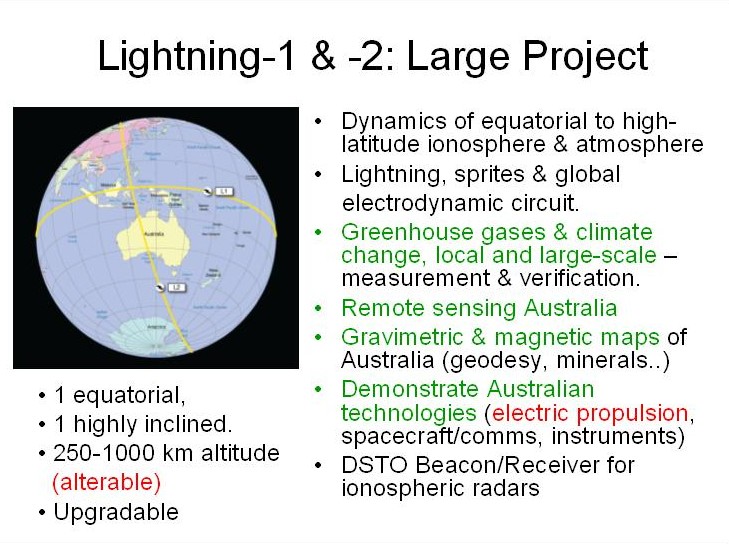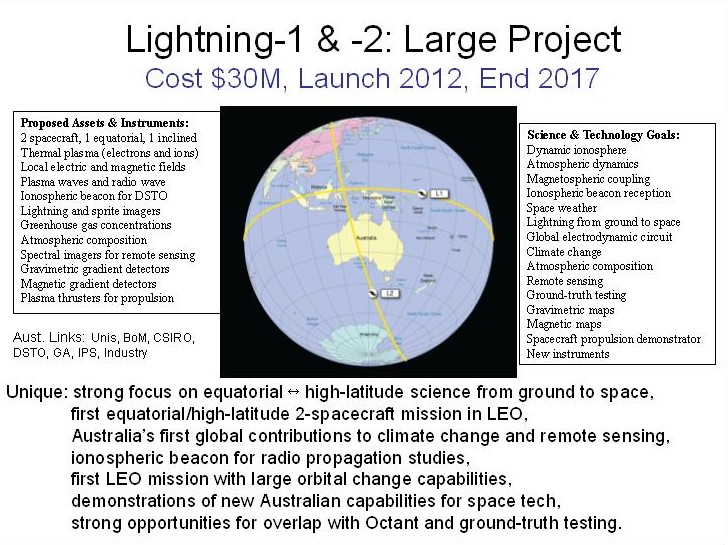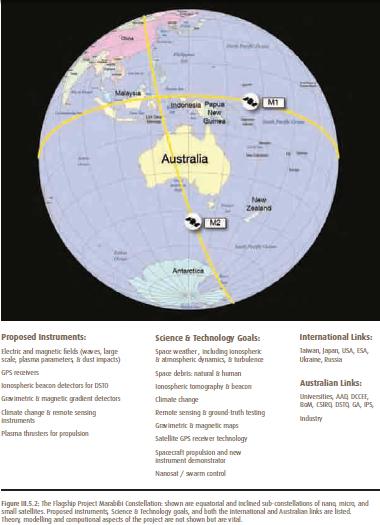

Source: PowerPoint talk presented at the Australian Space Science Conference in September 2007 (National Committee for Space Science)
Related news
Time to rejoin space race, say scientists (ABC Science Online)
Decadal Plan for Australian Space Science - Building a National Presence in Space (Australian Space Research Institute)
School of Physics Colloquia 2011 (University of Sydney)
11 April
Prof. Iver Cairns (University of Sydney; National Committee for Space Science)
Australia's new Decadal Plan for Space Science: Summary and implications for the University of Sydney
Abstract:
Australia was the fourth nation to launch a spacecraft into orbit from its own territory, in 1967. Its second satellite followed 35 years later, when FedSat was launched in December 2002. Australia has experts in many areas of space science, engineering, and technology, but for most of the last 50 years has had no coordinated national space effort or dedicated funding for space research. In order to remedy this situation and to organise the space science community, the National Committee for Space Science (Australian Academy of Science) developed the first Decadal Plan for Australian Space Science, which was launched on 27 September 2010. This talk has two parts. The first summarizes the Decadal Plan's vision for Australian space science and space capabilities. It presents some of the scientific themes and goals, together with the science, education, and outreach projects to accomplish them. Flagship projects include: Spaceship Australis, to make Australasia the region for which space weather effects are best measured and modelled from the Sun to the ground; Marabibi Constellation, a nano- and small-satellite constellation mission to study space weather, observe Earth, and develop space technology; and the Sundiver project. Medium projects range from digital radars to image and isotopic analysis laboraties to space propulsion. The second part of the talk identifies and discusses specific opportunities for the University of Sydney in space science and engineering, physics, and geoscience, among other areas. These include the i-INSPIRE project that involves members of the Schools of Physics and Aerospace, Mechanical, and Mechatronic Engineering, links to Marabibi Constellation, and may be the first Australian university spacecraft launched into orbit.
School of Physic takes INSPIRE-ing first step towards satellite launch (University of Sydney)
According to Prof. Cairns, the Marabibi Constellation is intended to have both nanosatellites (e.g. cubesats etc.) and small satellites (up to about 100 kg). Unfortunately the concept has not yet been approved by the Australian Government.
Launch of Australian Space Policy (Senator the Hon Kate Lundy, 09 Apr 2013)
The projects showcased included:
trialling hypersonic combustion ramjets - scramjets - capable of travelling at 8600 km per hour;
automated tracking of space debris, to prevent damaging collisions between satellites and man- made junk in orbit;
Australia's first two years Masters' program in satellite systems engineering; and
the development of Antarctic broadband, to provide broadband data and voice communications systems for the frozen continent.
Joint effort by SA and ACT to launch national space agency (August 21, 2017)
South Australia and the Australian Capital Territory have come together to advocate for the establishment of an Australian Space Agency.
Premier Jay Weatherill and ACT Chief Minister Andrew Barr will today sign a Memorandum of Understanding on behalf of their governments to work together towards the creation of a Canberra-based agency with a prominent presence in Adelaide.
The five-year agreement reflects both jurisdictions’ commitment to ensuring Australia can participate in the international space industry, which produces revenue of $420 billion annually
* National Space Industry Policy
Related links
2010-2019 Decadal Plan for Australian Space Science

Flagship 2: Marabibi Constellation, Years 2010-2019, 120 PhDs
Recommendation 9: Australia should develop a long-term near-Earth space capability by funding a multiple spacecraft project along the lines of the Marabibi Constellation, so as to build the required research infrastructure, perform world-first, student-focused, research on space weather, space technology, and Earth observation, and provide opportunities for strong education, training, outreach, and international collaboration.
National Committee for Space Science
MAGDAS(九州大学宙空環境研究センター)
オーストラリアに見る「研究開発」の育て方(上) | オーストラリアに見る「研究開発」の育て方(下)(宙の会)
2000万人という少ない人口で、どうやって経済成長を維持するか。クイーンズランド州が出した答えは、知識集約型産業への特化だった。州首相の「スマート・ステイト構想」に基づく支援と、その結果を検証する。
[satellite.html]



